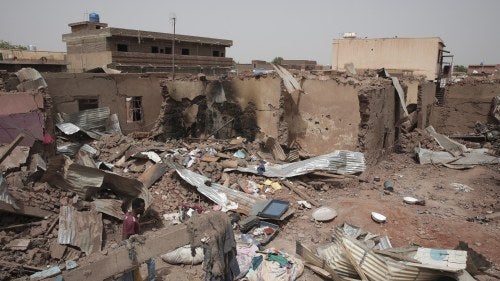Sudan's Humanitarian Crisis Overshadowed by Other Global Conflicts

Despite the scale of the crisis and its importance for the broader region, Sudan remains out of the minds of most Americans.
Since the April 15, 2023, outbreak of war between the Sudanese Armed Forces (SAF) and the paramilitary group Rapid Support Forces (RSF), Sudan has been consumed by conflict. The war has resulted in the deaths of thousands and the displacement of over eight million Sudanese in Khartoum, Darfur, and central Sudan—more than have been displaced in Gaza, and nearly as many as in Ukraine’s longer war. The country’s escalating humanitarian crisis has pushed it to the top of the International Rescue Committee’s 2024 Emergency Watchlist due to its scope and severity; US Ambassador to the United Nations Linda Thomas-Greenfield called the war in Sudan “the worst humanitarian crisis in the world.”
The war also has important implications for the region. With its abundant oil reserves, agricultural output, natural resources, and importance to maritime trade, Sudan is critical to the stability of the Red Sea region and the Horn of Africa. If the conflict continues, the humanitarian crises will likely increase tensions in a region already struggling with drought and instability. The Biden administration is beginning a new effort to bring an end to the conflict in Sudan by starting new peace talks, after months of private negotiations.
Despite Humanitarian Crisis, Sudan Not Receiving Global Attention
Despite the scale of the crisis and its importance for the broader region, Sudan remains out of the minds of most Americans. It’s also not on the minds of many pollsters: the war in Sudan has been largely underrepresented in media and public opinion polls around the globe as compared to the more frequent and detailed polling conducted about the conflicts in Ukraine and Gaza.
When asked directly, Americans are clearly aware that they know less about the current war in Sudan than other conflicts in the world. According to a YouGov poll on foreign conflicts conducted in October 2023—the point at which over 4.6 million people were newly internally displaced in Sudan—three-quarters of Americans (75%) said they either did not understand the conflict at all (31%) or understood it not very well (44%). Only a small minority (19%) said they somewhat understood it, and just 6 percent said they understood it very well. That’s far fewer than for other international hotspots. Majorities of Americans say they understand conflicts at least somewhat well.
Nor is the problem unique to the United States. An April 26-28, 2024, poll fielded by YouGov for the Catholic Agency for Overseas Development found that only 5 percent of adults in Great Britain believed Sudan was experiencing the world's largest humanitarian crisis.
Instead, Britons were more likely to point to Gaza (42%) or Ukraine (23%). Moreover, three-quarters of Brits (77%) were unaware of the United Nations’ warning of a potential famine in Sudan, a concern the UK’s own ambassador to the UN has highlighted repeatedly.
Americans Ready to Accept Sudanese Immigrants
Though Americans know they do not understand the conflict, that doesn’t mean they aren’t willing to help. In the 2023 Chicago Council Survey a majority of Americans (51%)—including majorities of Democrats (65%) and Independents (53%)—supported the idea of accepting Sudanese immigrants. However, only 31 percent of Republicans said the same. That partisan division may in part reflect a legacy of the Trump administration on immigration policy. In 2017, President Donald Trump issued an executive order banning people from entering the United States from Iraq, Syria, Iran, Libya, Somalia, Yemen and Sudan. According to a Quinnipiac University Poll in 2017, 46 percent of Americans supported the travel ban while 51 percent opposed it. When asked about suspending all travel by citizens of Iraq, Syria, Iran, Libya, Somalia, Sudan and Yemen to the United States for 90 days, a majority of Democrats (88%) and Independents (51%) opposed the idea while a majority of Republicans (88%) supported the suspension.
The Future of US-Sudan Relations
Despite the large casualties coming out of this conflict, Sudan will likely remain out of the global spotlight for the foreseeable future as the wars in Europe and the Middle East claim the lion’s share of attention. Unfortunately, this difference in attention has important consequences for the success of humanitarian relief and advocacy campaigns.
Compare the current conflict to the Darfur crisis 20 years ago. At the time, Darfur was the world's largest hunger crisis, and the conflict was front-page news around the world. And perhaps for that reason, the world got together to respond. President George W. Bush’s address to the United Nations General Assembly in 2004 put the issue front and center, and in a 2005 International Crisis Group/Zogby international opinion survey, a majority of Americans (84%) supported using American military assets to protect the civilian population of Darfur. Furthermore, a public opinion poll from GlobeScan Incorporated, The Program on International Policy Attitudes (PIPA), and Knowledge Networks showed a majority of Americans (61%) believed the best solution was a multilateral United Nations operation that would step in with military force to stop the violence in Darfur. In the Council’s own 2006 polling, half of Americans (49%) said the United Nations had not just the right to authorize an intervention, but the responsibility to do so.
With the United States launching a new initiative to support humanitarian efforts in Sudan, this will hopefully help raise awareness around the world that Europe and the Middle East are not the only regions with active conflicts, and potentially boost both public awareness of, and relief efforts to, the urgent crisis.
Correction: A previous version of this blog post misreported the findings of the 2017 Quinnipiac University Poll. We regret the error.


Related Content
 Defense and Security
Defense and Security
How can international partners help pave the way for a more peaceful future in Sudan?
 Global Politics
Global Politics
David Miliband joins the Council’s Ivo Daalder for a special episode of World Review.
 Global Politics
Global Politics
"The longer the conflict goes on, the more likely neighbors start choosing sides, raising the risk of sustained fighting in the long term," Elizabeth Shackelford writes.
